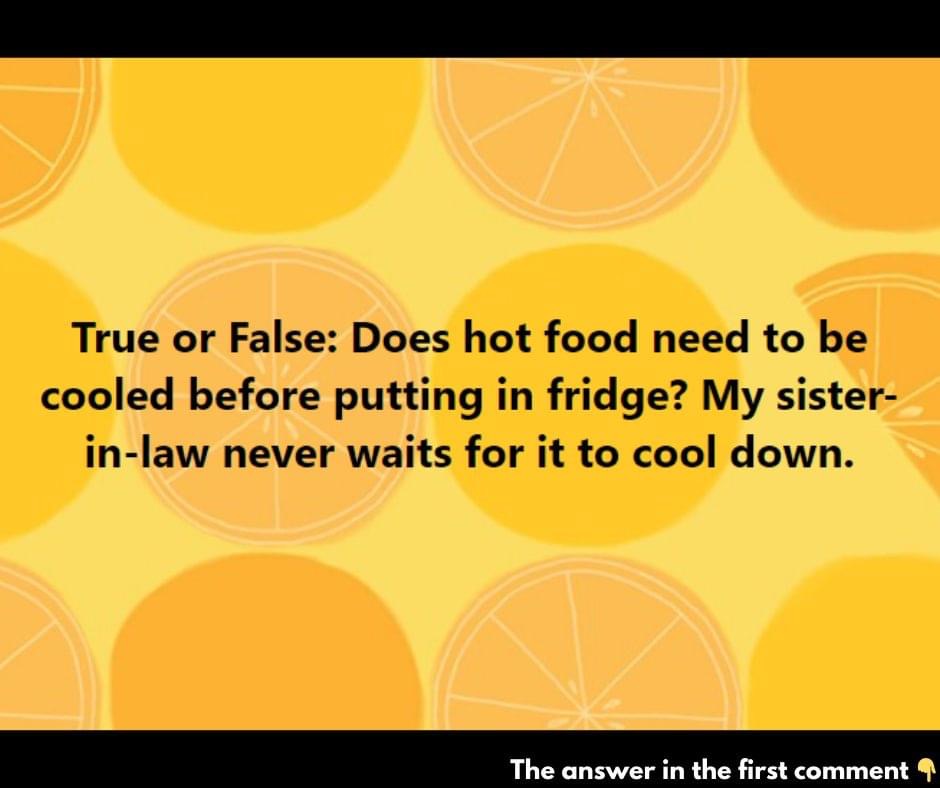
One of the most common questions in the kitchen is whether hot food needs to be cooled before being placed in the fridge. To maintain food safety and preserve the quality of your meals, it’s essential to understand the science and best practices around refrigerating hot food. Missteps in this process can lead to foodborne illnesses and compromised food quality. So, should you let hot food cool down first, or can you safely refrigerate it immediately?
In this article, we’ll explore the factors that determine when and how you should refrigerate hot food to keep it safe and delicious.
Understanding Food Safety
At the core of food safety is temperature control.
Harmful bacteria like Salmonella, E. coli, and Listeria thrive in the temperature range of 40°F (4°C) to 140°F (60°C), often referred to as the “danger zone.” In this zone, bacteria can multiply quickly, increasing the risk of foodborne illnesses. The goal is to cool hot food as quickly as possible to move it out of the danger zone and into a safe temperature range for storage.
The risk isn’t just about food being in the fridge but ensuring it gets there at the right time and temperature.
Why Cooling Hot Food Before
Refrigeration Matters
- Prevents Bacterial Growth: Bacteria multiply at an alarming rate when food is left in the danger zone. Rapidly cooling hot food helps prevent this growth and reduces the risk of foodborne illness.
- Preserves Food Quality: Slow cooling can degrade the texture, flavor, and nutritional value of your food. Rapid cooling helps maintain the integrity of vegetables, meats, and other perishables.
- Protects Other Foods in the Fridge: If you put very hot food directly into the refrigerator, it can raise the overall temperature inside, which may spoil other items already stored in there.
Best Practices for Cooling
Hot Food Safely
If you’re cooking in large batches or have a lot of leftovers, it’s crucial to follow the right steps to cool food quickly and safely. Here are some proven methods to ensure your food is out of the danger zone in no time:
- Allow Steam to Escape
After cooking, partially cover your food to allow steam to escape while still protecting it from contaminants. This promotes quicker cooling by releasing trapped heat. Using a lid or aluminum foil with a small gap works well.
2. Use Shallow Containers
When storing hot food, transfer it to shallow containers rather than large, deep ones. Shallow containers allow heat to dissipate more quickly, speeding up the cooling process. A large, deep container will hold heat for much longer, potentially keeping the food in the danger zone for an unsafe amount of time.
3. Monitor Temperature with a Food Thermometer
For the best results, use a food thermometer to ensure that your food is cooling quickly and safely.
Aim to reduce the food’s temperature from above
140°F (60°C) to below 40°F (4°C) within two hours.
This rapid cooling is essential to keep your food safe to eat later.
4. Divide Large Batches into
Smaller Portions
If you have a large quantity of hot food, divide it into smaller portions. Smaller portions will cool faster than one large container, significantly reducing the risk of bacterial growth.
5. Ice Bath Method
For even faster cooling, place the container of hot food into an ice bath. Make sure the ice surrounds the sides of the container without coming into direct contact with the food. This method is especially effective for soups, stews, and casseroles.
6. Stir the Food Periodically
Stirring your hot food as it cools helps distribute heat more evenly, speeding up the cooling process. This technique works especially well for thick dishes like stews or sauces, where the core temperature can remain high for a while.
7. Avoid Overcrowding the Fridge
When storing hot food, make sure not to overcrowd your refrigerator. Air circulation is critical to cooling food quickly. Place containers so that there’s space around them, allowing the cool air to do its job efficiently.
When Is It Safe to Refrigerate Hot Food?
Contrary to popular belief, it is safe to refrigerate hot food-under the right conditions. There are a few key points to keep in mind to ensure your food cools safely while protecting your refrigerator’s overall
1. Cool Partially Before
Refrigeration
While it’s not necessary to cool food entirely before refrigerating, it is helpful to let the food cool slightly before placing it in the fridge. Ideally, allow the food to cool down to below 140°F (60°C). This minimizes the strain on your refrigerator and ensures that other perishable items inside aren’t exposed to heat.
2. Don’t Leave It Out Too Long
Avoid leaving hot food at room temperature for too long. The USDA recommends that food should not remain in the danger zone (40°F to 140°F) for more than two hours. If your kitchen is particularly warm, reduce this time to one hour to ensure food safety.
3. Be Aware of Thermal Shock
If you’re dealing with a very hot container, it’s best to let it cool down on the countertop for a few minutes before transferring it to the fridge. Sudden temperature changes can cause glass containers or other sensitive materials to crack due to thermal shock. Protect both your food and your fridge by waiting a short while.
Conclusion
In conclusion, hot food does not need to be completely cooled before placing it in the refrigerator, but following safe cooling practices is essential. Allowing food to cool down slightly before refrigerating can prevent bacterial growth, protect the quality of your food, and safeguard the other items in your fridge. By understanding the risks of the temperature danger zone and using simple techniques like shallow containers, ice baths, and stirring, you can keep your food safe and delicious.